Arts
Why Australia's Aboriginal rock art will disappear
In 2060 Aboriginal rock art in Australia might have all but disappeared. Pollution, development, bureaucrats, vandals, fire and animals all play a role.

Wishing you knew more about Aboriginal culture? Search no more.
Get key foundational knowledge about Aboriginal culture in a fun and engaging way.
This is no ordinary resource: It includes a fictional story, quizzes, crosswords and even a treasure hunt.
Stop feeling bad about not knowing. Make it fun to know better.
Rock engravings are no longer renewed
During their spiritual cycle Aboriginal people periodically re-grooved their rock engravings which ensured that they survived the thousands of years this rock art is known to be old.
Today re-grooving is very rare since in many cases the traditional owners of the rock engravings have passed away and no-one has the authority to renew them.
Half the [Aboriginal rock art] sites in Australia could be lost in less than 50 years.
— Protect Australia's Spirit campaign [1]
Pollution
As a consequence Aboriginal rock art is exposed to environmental pollution. The groove depth decreased over the last decades, an effect which is accelerated by the increasing number of cars in Australia. While early explorers in the 1880s measured Indigenous rock engravings to be around one inch (25.4 mm) deep, this figure dropped to 16mm in the 1950s, 8 to 10mm in the 1990s and around 5mm in 2008 [2].
Aboriginal rock engravings lose about half a grain of rock per year. Even if an engraving is not directly exposed to rain, dew and fog settles on the rock and dissolves the 'glue' that holds together the grains.
While in traditional times it was customary to repair and renew art work, National Parks today don't allow Aboriginal people to do this, even though there are many people who could do the work [3].
Changes in the micro climate around rock art can affect them as well. "Even small changes in carbon dioxide levels, temperature and humidity can influence the growth of micro organism and algae and cause irreparable damage," says Robert Bednarik, founder of the Australian Rock Art Research Association [4].
In a few decades you will not be able to point out rock engravings you can still see today. In fact, whole figures and even whole panels of art have already completely disappeared [4].
The only rock art, the only petroglyphs that you are going to see 100 years from now are those very, very deeply carved. And they of course are a small minority.
— Robert Bednarik, Australian Rock Art Research Association, in 2008 [5]
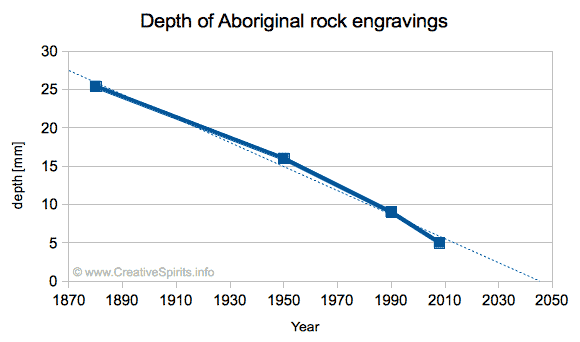
Desecration
Some non-Indigenous people tried to preserve Aboriginal rock art in painting the grooves with white paint (see image below). This act compares to desecration because rock engravings usually mark spiritual sites of great significance to Aboriginal people. When an engraving near Bondi Beach in Sydney was re-grooved in 1967 the Aboriginal community was divided as to whether this was a rightful act or not.
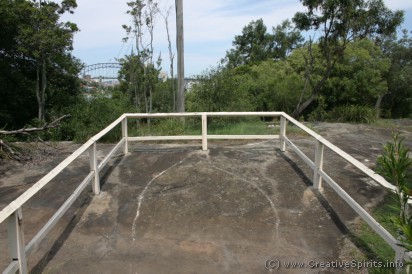
No more Aboriginal maintenance
Rock engravings and Wandjina art used to be regularly re-grooved, repainted and restored, but it's a practice that is dying out.
The thick ochres, especially the white pigment used in Wandjina paintings, sit on the surface of the rock and will eventually fade and crumble away. So, unlike the long-surviving Gwions, where the red pigment used permeates the rock, many Wandjinas are likely to disappear, leaving little trace [6].
Intentional destruction
Aboriginal sites are allowed to be 'disturbed' or destroyed by state governments. Between 2005 and 2009 the NSW government approved 541 permits to destroy or disturb Aboriginal heritage sites[7]. Not a single application to do so was rejected in the first 10 months of 2008.
Between June 2012 and June 2013, the NSW Office of the Environment and Heritage – the organisation supposed to protect Aboriginal heritage – considered 99 applications to destroy Aboriginal heritage and culture and approved all of them [8]. The Office claims, however, that only half of the applications reach this final step [8].
When the National Parks and Wildlife Act was enacted in 2001, last-minute lobbying by mining and agriculture interests prevented amendments that would have created a stricter protection regime for Aboriginal sites [7].
In 2009 a Tasmanian road project worth 164 million Australian dollars threatened to destroy "thousands of stone tools, quarry sites and campsites" and possibly several burial sites [9]. Work began before community consultations were completed.
During construction of Sydney's light rail to the eastern suburbs workers unearthed a large site with Aboriginal artefacts. Rather than protect this historic site, both state and federal governments rejected to pause development works.[10] Which other country would do that?
Europe's most ancient rock art sites in Spain and France date back an estimated 37,000 years and are well protected from the public and elements. Australia's rock art sites date back more than 60,000 years but are left open for anyone to access them as well as exposed to the elements.
We've got a system which is basically the managed destruction of Aboriginal heritage.
— David Shoebridge, NSW Greens MP [8]
Development
Development is just one of many threats to Aboriginal land and its art.
When companies 'develop' areas they might unintentionally or knowingly destroy destroy Aboriginal rock art. You rarely read about such cases in the press, so the following story is worth mentioning.
The Burrup Peninsula near Karratha in Western Australia holds what some believe is the largest and oldest open air rock art site in the world. Traditional owners accused cement company Cemex (later trading as Holcim) of having destroyed a 10,000-year-old quarry and two other sites [11] while carrying out rock blasting at Nickol Bay quarry in December 2008.
The damage to the sites has been found to be "significant" enough to warrant legal proceedings [12], but despite the possibility for a court case the company was only fined $280,000 by the federal government in February 2010, and obliged to pay an undisclosed sum of money to Aboriginal communities.
When Aboriginal art is found where companies operate, some claim it to be "questionable" or a "replica"--until proven wrong [13].
Vandalism
Time is not the only danger Aboriginal to rock art. Crude graffiti scratched into rocks bearing thousand-year-old images, vandals chiselling away the rock, construction camps built near sacred sites [5] and tourists (and locals) treading on rock art sites contribute to the decay of sites of priceless Aboriginal history.
When Rachel Perkins scouted locations for her extraordinary series First Australians she had to abandon Bull Cave due to graffiti.
"For instance, Bull Cave in Camden, down in Dharawal country. We went to film there because that was where the First Fleet's cattle escaped and they wandered down south and they went into Dharawal country and the Dharawal people painted this extraordinary image of this massive bull on the cave wall. It is one of the first pieces of contact art, a really important site. We went down there to film and of course, someone has spray painted across it in red letters: 'This is bullshit' and painted a big penis across it, so of course we can't film there." [14]
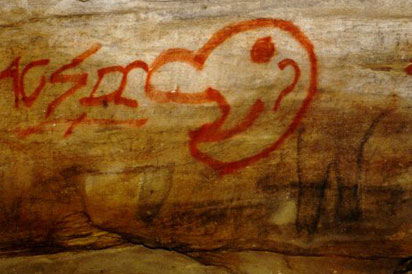
Other sites damaged by vandals include Red Hand Cave in the Blue Mountains (which now has been completely covered by perspex and bars), Bunjil Cave in Garriwerd, the Grampians (now protected by a metal cage), rock art at Mutitjulu waterhole at Uluru (Ayers Rock), Blackfellows Hands Reserve near Lithgow (NSW) and rock engravings in Darkinjung National Park which were destroyed by someone unloading wet cement onto it [14]. On the Burrup Peninsula in Western Australia Aboriginal elders recorded 15 to 20 sites with "significant" graffiti damage [15].
Vandalism and dust from busy roads are now two of the biggest threats to rock art in the north of the state [of Western Australia].
— Jane Balme, Associate Professor, Centre for Rock Art Studies, University of Western Australia [16]
Damaging heritage rock art can be punished by fines up to $110,000 or two years' imprisonment.
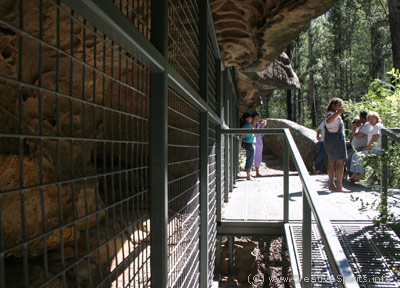
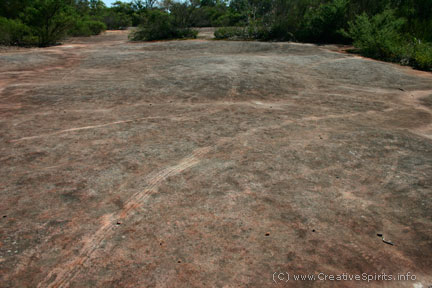
Theft

Theft is another problem. In a particularly bad example, vandals removed at least one rock face with power tools from the Burrup Peninsula, Australia's largest and oldest rock art site [5].
The Koori Mail reported in April 2009 about reports that Aboriginal artefacts were sold on eBay [17].
It is no wonder that some Aboriginal rock art sites are no longer listed or signposted. Australia needs to hide its most ancient art from its own people.
Insufficient legal protection
In 2009 if you had damaged Aboriginal rock art you could have gone away with it if you "didn't know or didn't intend to damage or remove Aboriginal artefacts or heritage sites" [17].
But this was only possible because legislation intended to protect rock art still hadn't been put in place. In 2001 the NSW government moved to amend the National Parks and Wildlife Act to make it an offence to disturb Aboriginal artefacts or sites. The law wasn't enacted due to "certain lobby groups" intervening (which most probably were miners or pastoralists).
Eventually the National Parks and Wildlife Amendment Bill 2010 passed through the NSW government. Now offenders cannot claim lack of intent anymore and a person or company is liable for the damages caused.
A 2011 State of the Environment report found Aboriginal heritage was neither well protected nor well recorded [18]. And it won't get better.
Between 2011 and 2014 the number of Aboriginal sites being registered for heritage protection dropped dramatically: From 80% of sites recommended to only 6%. 27 sites already registered had their heritage status cancelled in 2014. [18]
Of the handful of prosecutions that have even come before the courts in the last five years [2004-2009], the median penalty imposed is for $450—less than 10 per cent of the maximum.
— Ian Cohen, Greens Member of Legislative Council [17]
Bush fires
Many Aboriginal sites are mapped and open to the public. They are often accessible via boardwalks to protect them from visitors' feet (and hands).
Several Australian manufacturers offer boardwalks made from recycled plastic, praising their resistance to termites, water and mould. But there's one element they're not resistant to: fire. And that can have devastating consequences for the site they're meant to protect.
A bushfire in 2018 in Carnarvon National Park, about 600 kms northwest of Brisbane, reached Baloon Cave which used a recycled-plastic walkway. The structure caught fire and "exploded into a ball of flame", [19] obliterating the art above it beyond repair.
A similar incident occurred in 2008 where a fire at Keep River in the Northern Territory set off another recycled-plastic walkway and the resulting fireball destroyed numerous paintings and engravings within a natural stone archway. [20]
Feral animals
Aboriginal rock art which covers lower areas is prone to feral animals destroying it. Wild buffalo in the Northern Territory rub their bodies against rocks to get rid of parasites, destroying Aboriginal art.
Camel caravans have been blamed for extensive damage to sacred Aboriginal sites in arid regions of Australia. (Australia has the largest population of wild camels in the world, estimated to have topped one million in 2009, and exports them to the Middle East.)
Buffalo came here and rubbed themselves against the rocks because nobody cared about the land, and the paintings were disappearing.
— Romeo Lane, Indigenous ranger, Northern Territory [21]
Natural impacts
Nature itself weakens and destroys Aboriginal rock art:
- Water flow and rain
- Dust and wind
- Fire and smoke (for instance, sites in Keep River National Park (NT), Wollemi National Park (NSW) and elsewhere have been destroyed by fire)
- Cracking
- Collapse through erosion
- Vegetation growth or rubbing of stems and leaves
- Lichen and algal growth
- Mineralisation (salt/calcification)
- Insects (termites, bees) and animals
- Direct sunlight (changes in vegetation)
- Storms